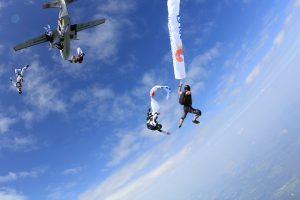Not every skydiver is a risk taker


Last modified: 17-09-2021
Skydivers are often perceived as thrill-seekers in need of high doses of adrenaline. This is confirmed by studies in which skydivers were compared to non-skydivers. However, another picture emerges from the study in which skydivers themselves were compared with each other.
Already in the 1970s, Hymbaugh and Garrett showed that skydivers scored higher on the sensation seeking scale than non-skydivers. This is confirmed by subsequent research. For example, Breivik (1995) and Jack and Ronan (1998) have shown that skydivers are higher sensation-seekers than mountaineers, glider pilots and car racers.
Other psychological tests also show differences between skydivers and people who do not practise extreme sports or engage in other extreme sports. In the article “Personality in extreme sports athletes” I once wrote about the differences in The Big Five between people practicing extreme sports, practicing less-risk sports, and who don’t practise any sports. Another personality test – MMPI, carried out by Delek (1973) showed that parachute jumpers are characterized by, among others, lower than average anxiety and depression and higher than average impulsiveness, hedonism and extroversion.
Piotr Próchniak (2011), who studied Polish parachute jumpers compared to people practicing sports characterized by a lower risk, also showed differences between these groups. In his study, skydivers were characterized by a greater impulsive sensation seeking and were more focused on the present. Moreover, they more often preferred quick death than slow death, and more believed in the control of death. They also differed in terms of some values, including they valued the exciting and hedonistic life more than the control group, and the tradition, help, tolerance and kindness towards others were less important to them. Monika Guszkowska and Agnieszka Bołdak (2010) compared the temperament of parachute jumpers and those practicing snowboarding and wakeboarding. All three groups were highly active (engaging in high stimulation behaviors), but the skydivers showed lower emotional reactivity (intensity of response to stimuli) and higher endurance (ability to respond appropriately under strong stimulation conditions) than the other two groups.
Temperament and the need for risk among skydivers
All the studies cited treated skydivers as a homogeneous group and compared them to people who practiced other sports or to “average” people in society. Everyone who skydives and knows many skydivers will admit, however, that not everyone is the same and skydivers differ in temperament and personality. Until recently, however, there had been no scientific research that focused only on skydivers. The first such research was conducted by Agnieszka Bołdak and Monika Guszkowska in 2013.
The researchers focused on temperamental traits, the need for stimulation and the need for risk. To test this, they used five psychological tests:
- temperamental traits test according to Jan Strelau’s Regulative Theory of Temperament,
- Marvin Zuckerman Sensation Seeking Scale,
- Ryszard Studenski’s Multifactor Risky Behavior Scale,
- STAI test measuring the level of anxiety,
- UMACL test to measure mood.
The participants of the study were 143 Polish skydivers, divided into two groups – beginners (maximum 10 jumps, average 5) and experienced (minimum 100 jumps, average 550). The STAI test was completed before and after the jump, while the remaining questionnaires were completed on days when they did not jump.
The results of the study allowed for the distinction of 3 groups of jumpers: Risk Avoiders, Sensation Seekers and Moderates.
Risk Avoiders
This group included 51 skydivers (36%), of which 28 were beginners and 23 experienced parachute jumpers. The temperament test showed that these people are characterized by a lower level of briskness (it is a tendency to react quickly, to fast-paced activities and the ability to easily change behavior depending on external conditions), lower sensory sensitivity (low ability to respond to weak sensory stimuli) and lower endurance and activity than the other two groups. They are less able to function for a long time under conditions of strong physical and mental stimulation. They are slower and less flexible, and may not respond optimally under conditions that require noticing and judging weak signals. Moreover, the Risk Avoiders group is characterized by a higher level of perseverance (the tendency to maintain a given behavior after the stimulus that caused the behavior ceases) and a higher emotional reactivity than the other two groups. These features indicate less ability to cope with stressful situations.
The skydivers from this group also showed the lowest results on the scale of sensation seeking and the scale of taking physical risk (risk that could lead to loss of life, health or pain).
Risk Avoiders are characterized by the greatest fear of jump, but at the same time the greatest decrease in post-jump anxiety. The mood test showed that people in this group had less feelings of pleasure and willingness to act than the other two groups and were more tense than the Moderate group.
The results of this group of parachute jumpers indicate that these individuals do not function at their optimal level of arousal during the jump. The stress of skydive can prevent the person from taking appropriate action, which can be especially dangerous in an emergency. Such skydivers should train on the ground a lot in order to develop the correct reflexes and thus reduce the risk of an incorrect or unresponsive reaction during the jump.
It is worth noting that the number of beginner and experienced parachute jumpers is similar in this group (and also in the others). This shows that some people practise skydiving for many years without having the right predisposition to do so. Thus, even experienced people, if they find themselves in a stressful, unusual situation, may make the wrong decision or take none. The risk of such a reaction (or lack of it) is greater in skydivers with the characteristics of Risk Avoiders than in people from other groups.
Sensation Seekers
Sensation Seekers constituted 39% of the study participants. 31 of them were beginners and 25 were experienced. The skydivers from this group are characterized by high briskness and activity as well as a strong sensation seeking. Therefore, they are people who are willing to undertake stimulating activities and are able to maintain a high pace of their activities.
The parachute jumpers in this group have a lower level of fear of jumping than the Risk Avoiders, however more than half of the jumpers in this group showed an increase in the level of anxiety after jump. This shows that these are people who are looking for strong sensations and skydiving gives them such sensations. High levels of stress are pleasing to them.
The mood test showed a greater feeling of pleasure and energy to act in the Sensation Seekers than in the Risk Avoiders and more tension than in the Moderates.
Sensation Seekers are better at dealing with stress than Risk Avoiders, but their temperamental traits may prompt them to take unnecessary risks. They can break safety rules and take actions that will increase their stress level, which will give them more pleasure from the skydive. Sensation Seekers may also overestimate their skills and underestimate risk. For this reason, such people can also be dangerous for themselves and other skydivers.
Moderates
In the group of Moderate there were 36 jumpers (25%). 14 people are beginners and 22 are experienced jumpers. The skydivers from this group are brisk, enduring and have high sensory sensitivitye. Moreover, they are characterized by the lowest emotional reactivity among all three groups and the lowest perseverance. Therefore, they are people who can easily adapt to changing conditions and are able to react to a low-intensity stimulus. They are mentally tough and can handle stressful situations well.
On the sensation seeking and risk-taking scale, this group scored moderately – higher than Risk Avoiders but lower than Sensation Seekers.
The fear of jumping was lower in this group of skydivers than in the group of Risk Avoiders, and after the jump lower than in both other groups. Their mood was more positive than the Risk Avoiders (more pleasure and energy). Moreover, they showed a lower tension level than the other two groups.
People from this group have the best predispositions to practice parachute jumping. During the jump, their body is at the optimal level of arousal, they are able to maintain adequate concentration and quickly make the right decision in an unusual situation. At the same time, they are not prone to taking unnecessary risks, which increases the safety of both themselves and other skydivers.
References
- Bołdak, A., Guszkowska, M. (2013). Are Skydivers a Homogenous Group? Analysis of Features of Temperament, Sensation Seeking, and Risk Taking. The International Journal of Aviation Psychology, 23(3), 197-212. (abstract at tandfonline.com)
- Delk, J. L. (1973). Some Personality Characteristics of Skydivers. Suicide and Life-Threatening Behavior, 3(1), 51-57. (abstract at wiley.com)
- Garrett, J. (1974). Sensation Seeking Among Skydivers. Perceptual and Motor Skills, 1974, 38, 118. (text at amsciepub.com)
- Próchniak, P. (2011). Psychological Profile of Polish Skydivers. Psychological Reports, 108, 263-273. (abstract at amsciepub.com)
Source of picture: Kurirolf [CC BY-SA 4.0 ], Wikimedia Commons
Author: Maja Kochanowska






Add comment